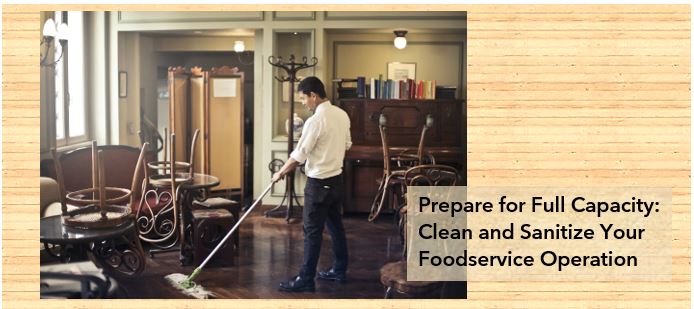As we all prepare for restaurant dining rooms to soon function at full capacity, restaurant owners have a lot to do to prepare. Now more than ever, cleanliness and sanitation are a top priority. From the moment a customer walks through your front door, they are looking for your establishment to provide ambience, quality food and a clean environment. Placing a high priority on food safety is one of the best ways to protect your customers, employees, and business reputation.
The steps to properly cleaning a restaurant can be broken down into four categories:
Clean:
to remove surface soils, you must ensure that you use cleaners the right way by following the manufacturers instructions carefully when using them. While cleaning does not kill pathogens, it is the most important part of the hygiene process because it impairs the environment where those pathogens would thrive. First, prior to washing, large food particles must be removed from surfaces through soaking, scraping, or scrubbing, Floor cleaning supplies and equipment can help with this step.
Sanitize:
to kill 99.9% of germs (bacteria) accepted as food safe by public health dept. Sanitizing reduces the amount of bacteria or germs on a surface to safe levels. Make sure you mix sanitizers to the right concentration as the concentration of the mix is critical. Too little sanitizer and it will not be effective in reducing pathogens, too much, and the solution can be unsafe. Only use chemicals that are approved for use in a foodservice operation. Don’t forget that Hand Sanitation is also is critically important to the prevention of cross-contamination and the spread of germs.
Disinfect:
to kill 99.9999 of all germs (bacterial & virus). For disinfecting, focus on high-touch objects in the dining room. Doorknobs, door handles and push plates, railings, light and air control switches, faucets, toilet flush levers and the restrooms.
Food Safe:
Only use chemicals that are approved for use in a foodservice operation. Always cover or remove items that could become contaminated before using chemicals, after using chemicals, make sure to clean and sanitize equipment and utensils. Store the chemicals separately from food and equipment by either spacing the chemicals apart from these items or partitioning off the chemicals from other items stored in the same area.
Before opening the doors for diners again, it is a good idea to clean, sanitize, disinfect, and ensure food safety of the entire operation before welcoming all your guests back in for business. Keep your institutional kitchen clean and sanitary from floor to ceiling with all the best janitorial supplies and equipment.
